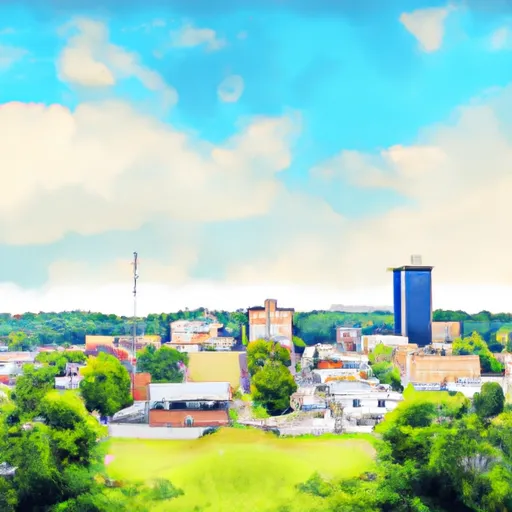-
 Snoflo Premium
Snoflo Premium
Get unlimited access to all our content
With no Ad interruptions! - Start Your Free Trial Login with existing account
Stearns
Eden Index
Climate
7.9
•
Recreation
4.8
•
Community
•
Safeguard
4.8/10

Stearns, Kentucky is a charming town located in McCreary County. Known for its beautiful natural surroundings, Stearns offers a pleasant climate characterized by mild winters and warm summers. The area experiences a humid subtropical climate, with average temperatures ranging from the low 30s (°F) in winter to the mid-80s (°F) in summer. Visitors can enjoy pleasant weather for most of the year, making it an excellent destination for outdoor enthusiasts.
Hydrology plays a significant role in Stearns' natural beauty. The area is surrounded by numerous pristine rivers and streams, including the scenic Big South Fork Cumberland River. These waterways provide excellent opportunities for activities such as fishing, kayaking, canoeing, and even whitewater rafting. Additionally, the region boasts stunning waterfalls, such as Yahoo Falls and Cumberland Falls, which offer breathtaking views and nature trails for hiking.
Outdoor recreation opportunities in Stearns are abundant. The town serves as a gateway to the Big South Fork National River and Recreation Area, providing access to over 125,000 acres of protected land. Here, visitors can explore a network of trails for hiking, horseback riding, and mountain biking. Camping and picnicking facilities are also available, allowing visitors to immerse themselves in the beauty of the surrounding forests. Stearns is a haven for nature lovers seeking a tranquil escape and exciting outdoor adventures.
What is the Eden Index?
The Snoflo Eden Index serves as a comprehensive rating system for regions, evaluating their desirability through a holistic assessment of climate health, outdoor recreation opportunities, and natural disaster risk, acknowledging the profound impact of these factors on livability and well-being.
Climate Health Indicator (CHI): 7.9
Stearns receives approximately
1309mm of rain per year,
with humidity levels near 80%
and air temperatures averaging around
13°C.
Stearns has a plant hardyness factor of
6, meaning
plants and agriculture in this region thrive during a short period during spring and early summer. Most
plants will die off during the colder winter months.
By considering the ideal temperature range, reliable water supplies, clean air, and stable seasonal rain or snowpacks, the Climate Health Indicator (CHI) underscores the significance of a healthy climate as the foundation for quality living.
A healthy climate is paramount for ensuring a high quality of life and livability in a region, fostering both physical well-being and environmental harmony. This can be characterized by ideal temperatures, reliable access to water supplies, clean air, and consistent seasonal rain or snowpacks.
Weather Forecast
Streamflow Conditions
Upper Cumberland
Area Rivers
Upper Cumberland
Snowpack Depths
Upper Cumberland
Reservoir Storage Capacity
Upper Cumberland
Groundwater Levels
Recreational Opportunity Index (ROI): 4.8
The Recreational Opportunity Index (ROI) recognizes the value of outdoor recreational options, such as parks, hiking trails, camping sites, and fishing spots, while acknowledging that climate plays a pivotal role in ensuring the comfort and consistency of these experiences.
Access to outdoor recreational opportunities, encompassing activities such as parks, hiking, camping, and fishing, is crucial for overall well-being, and the climate plays a pivotal role in enabling and enhancing these experiences, ensuring that individuals can engage in nature-based activities comfortably and consistently.
Camping Areas
| Campground | Campsites | Reservations | Toilets | Showers | Elevation |
|---|---|---|---|---|---|
| Lake Conasauga Overflow | 13 | 3,172 ft | |||
| Ridgeway - Carters Lake | None | 1,282 ft | |||
| Jacks River Fields | 14 | 2,865 ft | |||
| Lake Conasauga | 35 | 3,152 ft | |||
| Woodring Branch - Carters Lake | None | 1,142 ft | |||
| Fort Mountain State Park | None | 2,656 ft | |||
| Doll Mountain - Carters Lake | None | 1,206 ft | |||
| Cottonwood Patch | 9 | 971 ft | |||
| Salacoa Creek Park | 35 | 752 ft | |||
| Harris Branch - Carters Lake | None | 1,230 ft |
Nearby Ski Areas
Catastrophe Safeguard Index (CSI):
The Catastrophe Safeguard Index (CSI) recognizes that natural disaster risk, encompassing floods, fires, hurricanes, and tornadoes, can drastically affect safety and the overall appeal of an area.
The level of natural disaster risk in a region significantly affects safety and the overall livability, with climate change amplifying these risks by potentially increasing the frequency and intensity of events like floods, fires, hurricanes, and tornadoes, thereby posing substantial challenges to community resilience and well-being.
Community Resilience Indicator (CRI):
The Community Resilience Indicator (CRI) recognizes that education, healthcare, and socioeconomics are crucial to the well-being of a region. The CRI acknowledges the profound impact of these elements on residents' overall quality of life. By evaluating educational resources, healthcare accessibility, and economic inclusivity, the index captures the essential aspects that contribute to a thriving community, fostering resident satisfaction, equity, and social cohesion.

